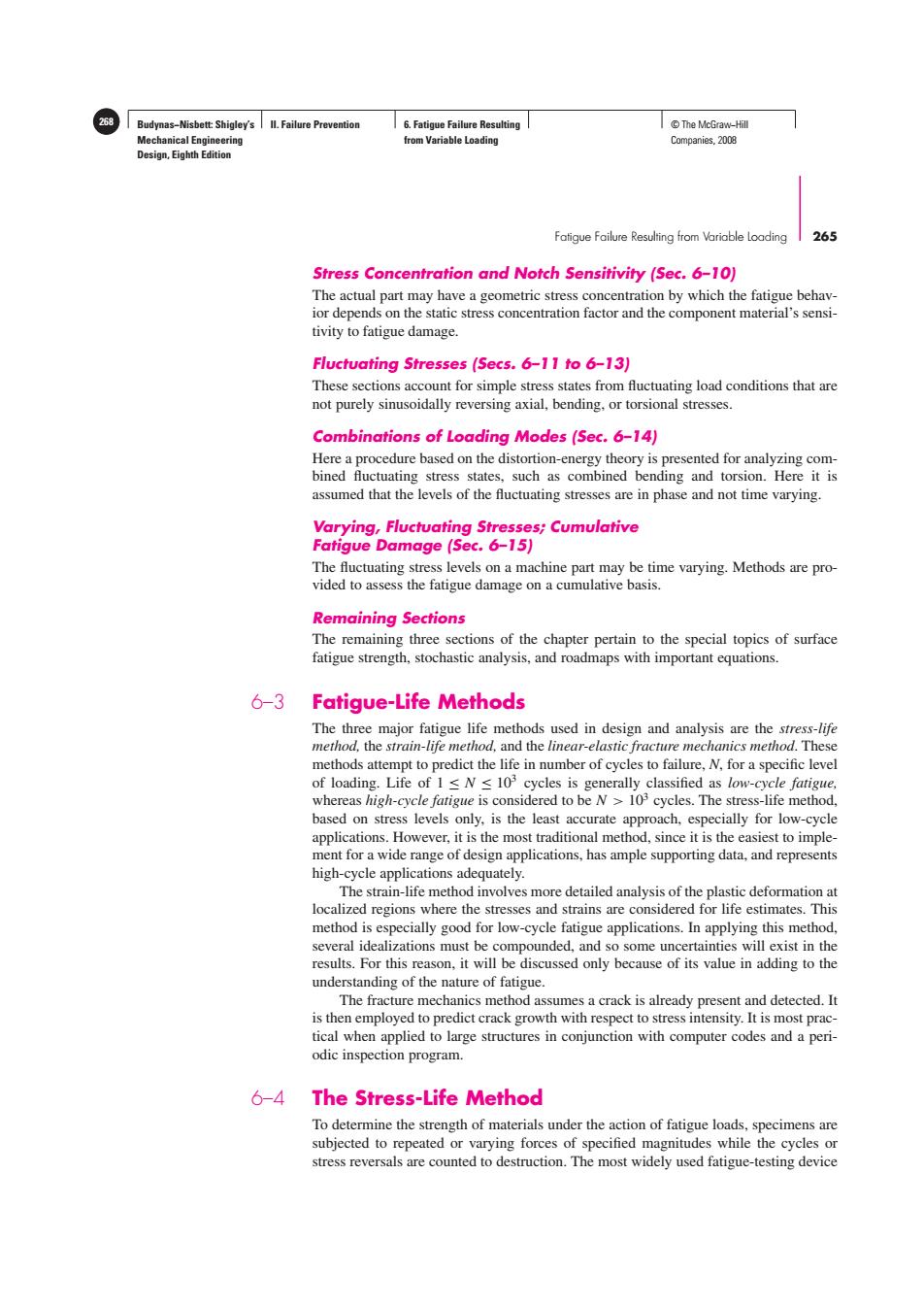正在加载图片...

258 Budynas-Nisbett:Shigley's ll.Failure Prevention 6.Fatigue Failure Resulting I©The McGraw-Hil Mechanical Engineering from Variable Loading Companies,2008 Design,Eighth Edition Fatigue Failure Resulting from Variable Loading 265 Stress Concentration and Notch Sensitivity(Sec.6-10) The actual part may have a geometric stress concentration by which the fatigue behav- ior depends on the static stress concentration factor and the component material's sensi- tivity to fatigue damage. Fluctuating Stresses (Secs.6-11 to 6-13) These sections account for simple stress states from fluctuating load conditions that are not purely sinusoidally reversing axial,bending,or torsional stresses. Combinations of Loading Modes(Sec.6-14) Here a procedure based on the distortion-energy theory is presented for analyzing com- bined fluctuating stress states,such as combined bending and torsion.Here it is assumed that the levels of the fluctuating stresses are in phase and not time varying. Varying,Fluctuating Stresses;Cumulative Fatigue Damage (Sec.6-15) The fluctuating stress levels on a machine part may be time varying.Methods are pro- vided to assess the fatigue damage on a cumulative basis. Remaining Sections The remaining three sections of the chapter pertain to the special topics of surface fatigue strength,stochastic analysis,and roadmaps with important equations. 6-3 Fatigue-Life Methods The three major fatigue life methods used in design and analysis are the stress-life method,the strain-life method,and the linear-elastic fracture mechanics method.These methods attempt to predict the life in number of cycles to failure,N,for a specific level of loading.Life of 1 sN<103 cycles is generally classified as low-cycle fatigue, whereas high-cycle fatigue is considered to be N>103 cycles.The stress-life method, based on stress levels only,is the least accurate approach,especially for low-cycle applications.However,it is the most traditional method,since it is the easiest to imple- ment for a wide range of design applications,has ample supporting data,and represents high-cycle applications adequately. The strain-life method involves more detailed analysis of the plastic deformation at localized regions where the stresses and strains are considered for life estimates.This method is especially good for low-cycle fatigue applications.In applying this method, several idealizations must be compounded,and so some uncertainties will exist in the results.For this reason,it will be discussed only because of its value in adding to the understanding of the nature of fatigue. The fracture mechanics method assumes a crack is already present and detected.It is then employed to predict crack growth with respect to stress intensity.It is most prac- tical when applied to large structures in conjunction with computer codes and a peri- odic inspection program. 6-4 The Stress-Life Method To determine the strength of materials under the action of fatigue loads,specimens are subjected to repeated or varying forces of specified magnitudes while the cycles or stress reversals are counted to destruction.The most widely used fatigue-testing deviceBudynas−Nisbett: Shigley’s Mechanical Engineering Design, Eighth Edition II. Failure Prevention 6. Fatigue Failure Resulting from Variable Loading 268 © The McGraw−Hill Companies, 2008 Fatigue Failure Resulting from Variable Loading 265 Stress Concentration and Notch Sensitivity (Sec. 6–10) The actual part may have a geometric stress concentration by which the fatigue behavior depends on the static stress concentration factor and the component material’s sensitivity to fatigue damage. Fluctuating Stresses (Secs. 6–11 to 6–13) These sections account for simple stress states from fluctuating load conditions that are not purely sinusoidally reversing axial, bending, or torsional stresses. Combinations of Loading Modes (Sec. 6–14) Here a procedure based on the distortion-energy theory is presented for analyzing combined fluctuating stress states, such as combined bending and torsion. Here it is assumed that the levels of the fluctuating stresses are in phase and not time varying. Varying, Fluctuating Stresses; Cumulative Fatigue Damage (Sec. 6–15) The fluctuating stress levels on a machine part may be time varying. Methods are provided to assess the fatigue damage on a cumulative basis. Remaining Sections The remaining three sections of the chapter pertain to the special topics of surface fatigue strength, stochastic analysis, and roadmaps with important equations. 6–3 Fatigue-Life Methods The three major fatigue life methods used in design and analysis are the stress-life method, the strain-life method, and the linear-elastic fracture mechanics method. These methods attempt to predict the life in number of cycles to failure, N, for a specific level of loading. Life of 1 ≤ N ≤ 103 cycles is generally classified as low-cycle fatigue, whereas high-cycle fatigue is considered to be N > 103 cycles. The stress-life method, based on stress levels only, is the least accurate approach, especially for low-cycle applications. However, it is the most traditional method, since it is the easiest to implement for a wide range of design applications, has ample supporting data, and represents high-cycle applications adequately. The strain-life method involves more detailed analysis of the plastic deformation at localized regions where the stresses and strains are considered for life estimates. This method is especially good for low-cycle fatigue applications. In applying this method, several idealizations must be compounded, and so some uncertainties will exist in the results. For this reason, it will be discussed only because of its value in adding to the understanding of the nature of fatigue. The fracture mechanics method assumes a crack is already present and detected. It is then employed to predict crack growth with respect to stress intensity. It is most practical when applied to large structures in conjunction with computer codes and a periodic inspection program. 6–4 The Stress-Life Method To determine the strength of materials under the action of fatigue loads, specimens are subjected to repeated or varying forces of specified magnitudes while the cycles or stress reversals are counted to destruction. The most widely used fatigue-testing device